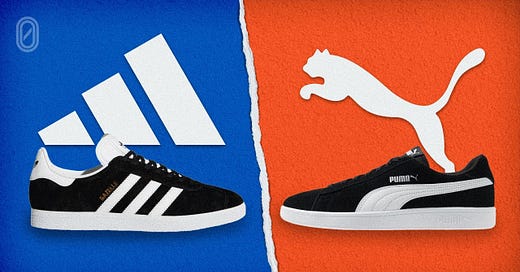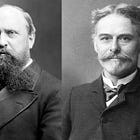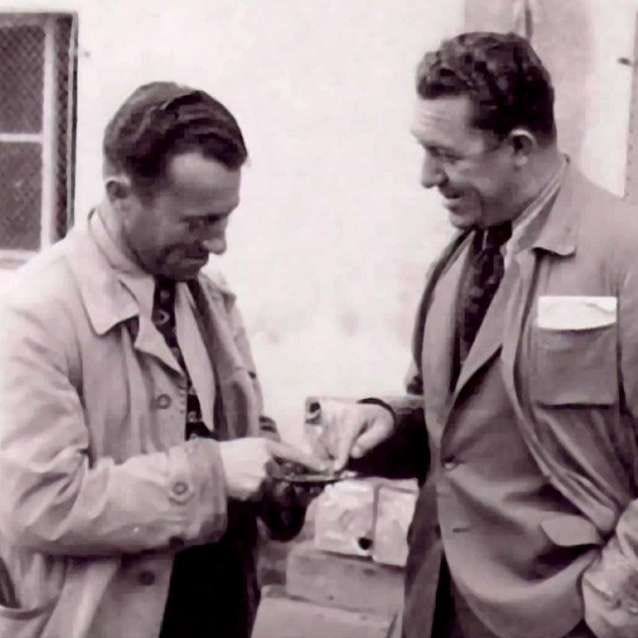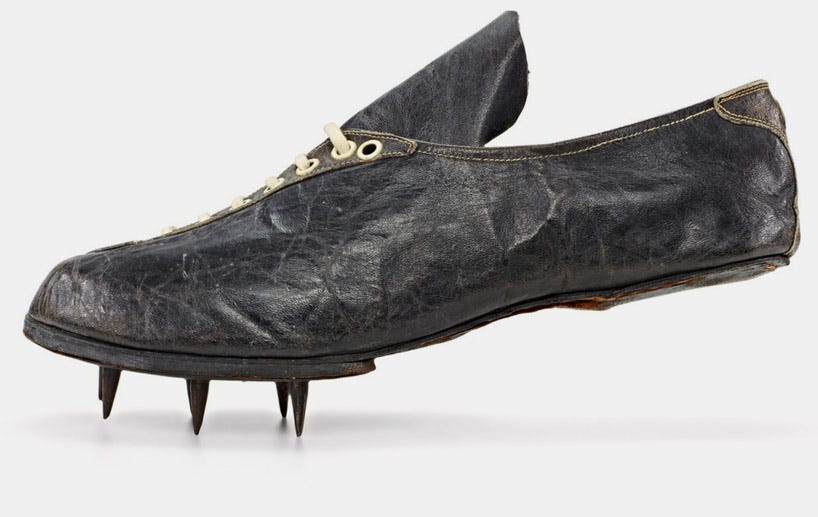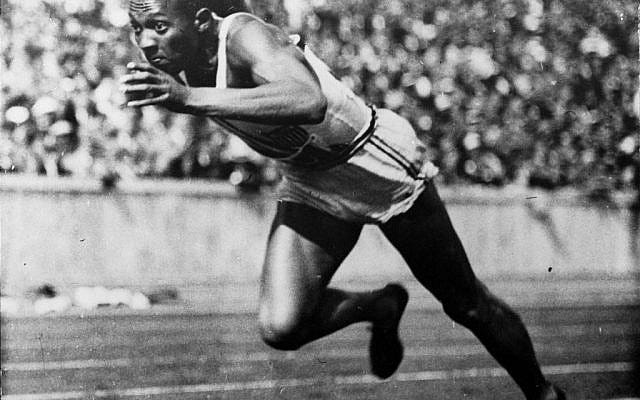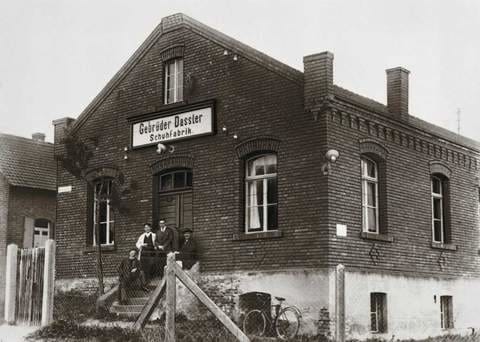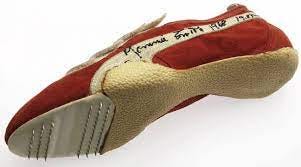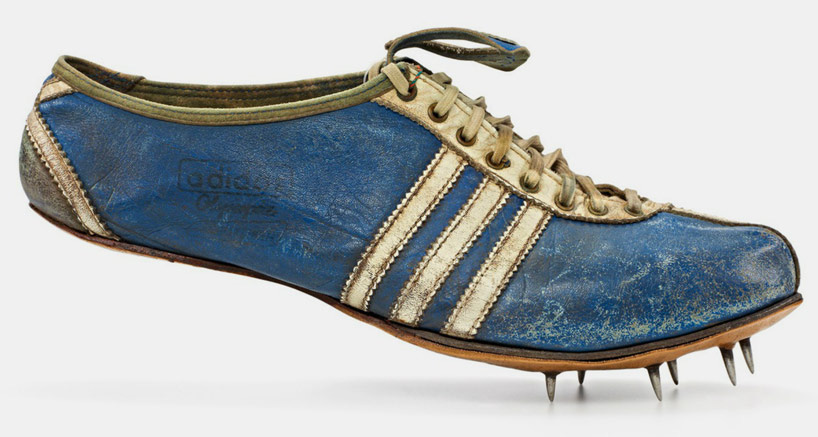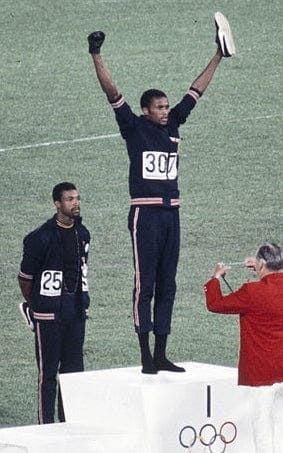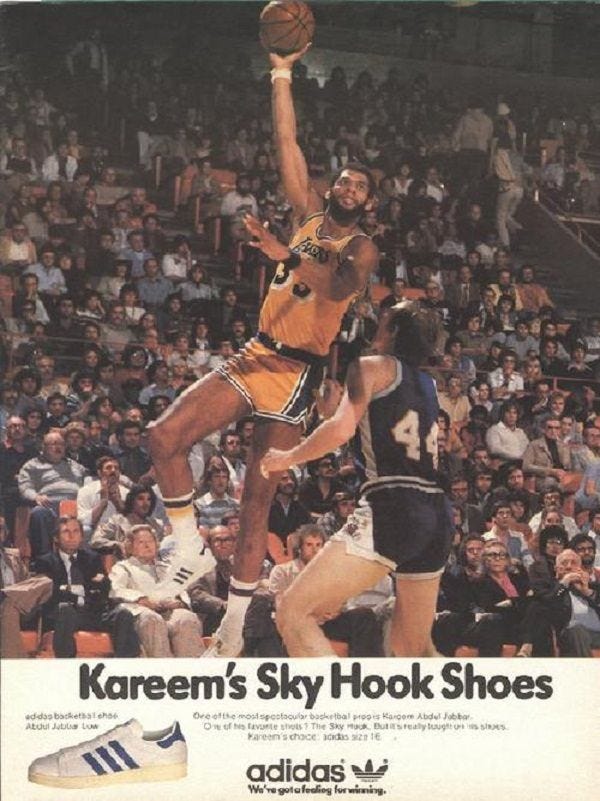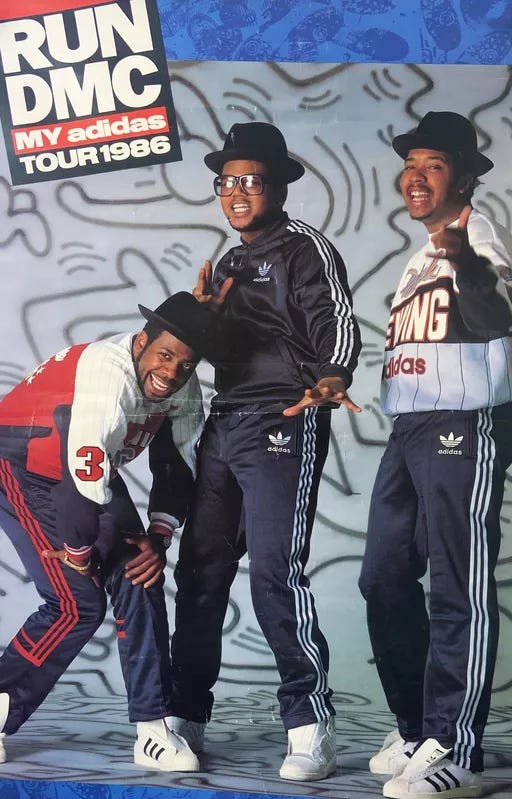The Sneaker Wars
Arrests, bribes and spying, all in pursuit of global domination of the sneaker market.
Last week I wrote about the insane Bone Wars and the rivalry between two paleontologists (click above to read that crazy story). Today I will look at and even crazier rivalry. Actually it’s a rivalry and then the creation of the sports landscape. Two stories for the price of one. Our rivalry is between the shoe companies Adidas and Puma and the second story is about Horst Dassler and the creation of the sports world as we know it today.
Our story starts in Germany with the birth of Rudolf “Rudi” Dassler in 1889 and with the birth of his brother Adolf “Adi” in 1900. They were both born to Christoph and Pauline Dassler in Herzogenaurach, a small town near Nuremberg in what was than the German Empire. Christoph owned a small shoe company and Pauline ran a laundry out of their house. As children, Rudolf and Adolf worked for their mother and were known around town as the Laundry Boys. They also had great interest in their father’s shop and came to love the business.
After World War I which saw both brothers called up to fight but live the hell that were the trenches. Adi and Rudi began repairing shoes in their hometown when they returned, with the business being run out of their mother’s laundry room. Times were tough and material was in short supply. Adi collected leather from old helmets for shoes. Rudi used the silk from parachutes to make bedroom slippers. Eventually they founded the shoe manufacturing company Gebrüder Dassler Schuhfabrik (Dassler Brothers Shoe Factory). Adi was really into sports and In 1920 the Dasslers started making specialty shoes for sports, especially for track with hand forges nails driven through the soles as spikes and for soccer with replaceable cleats. Although the economic conditions were still very bad, Germans need to get their minds off their situation and sports was a great way to accomplish that.
By 1925, they had made a name for themselves with their leather football (soccer) shoes and their track shoes. Adi, who was shy but inventive was the driving force behind innovation and production, while Rudi, boisterous and outgoing, was the salesmen of the pair.
By the early 1930s things were going well at Dassler Brothers, despite the complex political climate in Germany. The Dassler brothers were some of the first to champion specialized sporting footwear, and their early designs caught the eye of Josef Waitzer, former Olympian and the then-coach of Germany’s Olympic track and field team. After travelling from Munich to Herzogenaurach to get a look at the shoes for himself, Waitzer and the Dasslers struck up a friendship that would prove immeasurably valuable in the years ahead. In 1936, the brothers were given the opportunity to outfit both domestic and foreign athletes for the 1936 Summer Olympics in Berlin. The games ultimately acted as an international springboard for the Dasslers. Their shoes, were front and center throughout. Most notably, in the case of Jesse Owens.
Owens, who received shoes from the Dasslers themselves ahead of the Games, wore their spikes on his way to four gold medals and one of the most iconic performances in Olympic history.
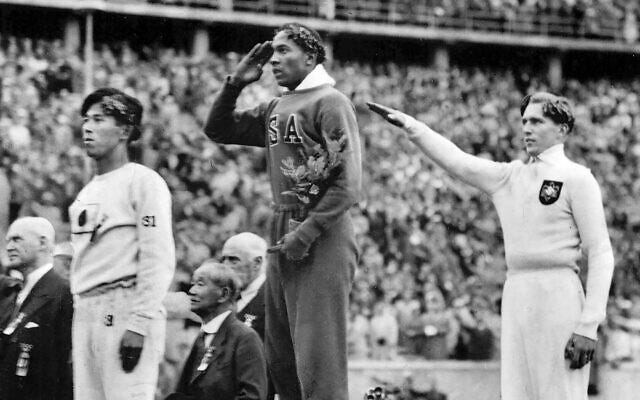
Sales spiked (pun intended) after he games with large orders for track and field, soccer and even baseball shoes beginning to come in. Eventually, in the lead up to World War II, they were making 200,000 pairs a year.
Unfortunately for the Dasslers, they were never truly able to enjoy the success of their company. Instead, their relationship quickly became strained from tensions arising from the success, as well as the fact that their wives couldn’t get along. Rudi married a woman named Friedl Strasser who was quite content to be a house frau and not get involved in the business. Adi, on the other hand, married Käthe Martz who thought of herself as an equal partner with Adi in all business decisions. She awas always getting involved in the brothers’ disputes and Rudi believed that she was trying to drive a wedge between the brothers and push Rudi out of the business. All of this drama occurred, not only along side the growing clouds of war but also while both families were living in the same villa.
Things only worsened once World War II began. Adi, as the perceived leader of the business was released from military service, further straining his relationship with Rudi. Things came to a head in February 1943 when Herzogenaurach was bombed by the Allies. As Adi and Käthe climbed into a bomb shelter already occupied by Rudolf and Friedl, Adi supposedly exclaimed, ‘The dirty bastards are back again!’”, in reference to the Allied bombers. Rudolf, however, was convinced that the remark was directed at him, and the feud between the two brothers escalated to new heights. After that moment in the bomb shelter, things would never be the same for the Dassler family. With the war in full swing, many factory operations were shut down or changed to the production of war material. In fact, in 1944, the Dassler factory was nationalized and ordered to make panzerschrecks (the German version of the bazooka) for the Wehrmacht, instead of shoes for civilians.
Late in the war, with the situation looking bad for Germany, the Nazis were drafting men outside of the normal age of service, both men that were too old and boys what were too young. However, when Rudi was called up for service, he immediately suspected that Adi had conspired to have him called up to get him out of the way. He was right, Adi had indeed mentioned to the local army recruiter that Rudi was not running things at the factory and could be called up for service. Rudi was drafted into the army and sent to Poland. Rudolf devised a plan to escape his post on the Eastern Front and return to the factory. He successfully made it back to Herzogenaurach but by then his father has very I'll and shortly thereafter Christoph died Rudi was arrested the day after the funeral and the Gestapo ordered he be sent to Dachau with a few other prisoners. However, on the journey the guard received orders to kill all the prisoners. Luckily for everyone, the guard took pity on them and released all the prisoners. Rudi was eventually captured by the Americans and interrogated. He told the Americans his story, but also added that his brother was a true Nazi and had voluntarily switched the factory to making weapons. Rudi told the US Army that he would have not made that decision but he had been in custody of the Gestapo and his hands had been tied. The US dragged them Adi in for questioning. Adi was classified as a belasteter (literally burdened, the second highest level of Nazi offender) by a denazification panel and was facing potential time in prison as well as removal from management in the shoe company, but the story Adi told was different. He said the factory had been nationalized and he had no choice but to go along. He added that it was his brother that the Americans should be talking to since he had really been working for the Gestapo all along. Rudi was brought back in for questioning and it took the Americans a year to straighten out their competing stories.
The relationship of the Dassler brothers had slowly been deteriorating throughout the war, and now it had became irreparable. In 1948, outraged with one another’s actions during the war, and the constant struggle to gain power, the Dassler brothers divided the company, its assets and employees. The negotiations while separating the company would be the last time the Dassler brothers would speak to one another for years. Adi retained the newer Dassler shoe factory while Rudolf moved south of the Aurach river and took over the older smaller factory. The brothers allowed the employee to decide who they wanted to work for. The technicians chose to stay with Adi and the sales force stayed with Rudi. Even the Dassler family was split, with their sister Marie choosing Adi and the mother picking Rudi. Both of the brothers looked to rename their companies and differentiate themselves in the market. Adolf struck gold when he combined his first name “Adi” and his last name “Dassler” to form “Adidas”. Rudolf tried to copy Adi by naming his company “Ruda”, but the name was quickly changed to “Puma” to sound more athletic. The rivalry of Adidas and Puma was born and would divide the city just as it had divided the company. Nearly everyone in the town ended up working for either Adidas or Puma, employees of the two firms and their families did not socialize and avoided speaking to each other. They patronized separate banks, bars, grocery stores, bakeries and barber shops. Because of the residents habit of looking at everyone’s shoes to see who they were affiliated with, Adidas or Puma, Herzogenaurach got the nickname "the town of bent necks".
Adi had the first innovation, most track shoes had two leather strips going from the sole to the top of the shoe to add stability, but they were all the same color as the leather. Adi realized that if he made his strips white it would set his shoes apart and be easily recognizable. Rudi, however, had the sales contacts and initially took the lead in the race between the two companies. A turning point in the battle was the 1954 soccer World Cup. In 1952, Rudi had gotten into an argument in 1953 with a German soccer coach, because apparently the coach didn’t show enough deference to Rudi. Unfortunately for Rudi and Puma, the coach, Sepp Herberger, was named the coach of the West German National Team and would not equip his team with Puma shoes. That left the door open for Adi, and he gladly supplied shoes to their players. The 1954 World Cup was the first World Cup that was broadcast on international television and in the final it was underdog Germans versus the favorites Hungry. The weather during the match turned bad and a torrential rain began near the end of the first half. During halftime, the Germans used the replaceable cleat for the Adidas and put on longer cleats for more traction on the muddy pitch. Germany ended up making a comeback and winning 3-2 and the television viewers saw them in Adidas shoes.
By 1950 Adi was giving more authority to his son Horst and Rudi did the same thing for his son Armin. And if you thought the rivalry between the Dassler brothers was bad, just wait to to see how horrible and insane it is between the Dassler cousins!


The opening shot in the second generation of the Dassler feud started in 1956 when Horst bribed customs officials during the Melbourne Olympics to keep crates of Puma shoes on the dock for most of the games, allowing 70 athletes to win medals wearing Adidas shoes. This incarnation of the he feud didn’t just involve the Dasslers themselves, it also involved their employees. Before major international sporting events Adidas people would call hotels and rental car companies and cancel Puma reps hotel and car reservations, leaving them stranded with no place to stay. Puma employees would do the same to Adidas people. Leaving the employees of two biggest shoe companies homeless and without transportation at the most inopportune times.
While it was crazy up until now, during the 1968 Mexico City Olympics things reached a whole new level of insanity.
In the run up to the games, the International Olympics Committee (IOC) announced that a new type of track surface was going to be used in Mexico City, a red spongy surface would replace the old black asphalt track. Armin and the people at Puma who had heard rumors of this change had started working on something new and by the time of the announcement of the new surface, had invented a new type of track shoe, one that had 68 tiny spikes instead of the traditional large six spikes of the traditional track shoes. The new shoes allowed runners to have much more grip while running, especially in the turns. During United States Track and Field Trials, where they had a track with the new surface, athletes set world records in nearly every heat of every running event. Horst Dassler heard about the new shoes and the out of this world performance of the Americans, and knew that those shoes would catapult Puma into the led in their battle for world sneaker domination. He decided to fall back on a tactic that had worked well for him in Melbourne. He bribed officials. This time it was IOC officials, to ban the new Puma shoe for breaking a rule regarding the number of spikes allowed on a shoe. Puma argued that their 68 tiny “spikettes” were the same amount of metal as six giant spikes on most shoes, but the IOC
responded that rules or interpretations of rules could not be changed during an Olympic year and therefore the Puma shoes were banned. It didn’t stop the shoe from making an appearance at the games, however. Most of us a familiar with the photo of Tommie Smith and John Carlos raising their black-gloved fists above their heads, but less people know another picture taking near the same moment. It shows Tommie Smith alone on the podium about to have the gold medal draped around his neck. He is stocking feet, has his hands raised above his head. On his right hand he's wearing the black glove and on his left hand he has a single Puma brush spike shoe. In the background is John Carlos and it appears that he is also holding a Puma shoe.
This is not an accident. The stunt on the podium was just another way for Puma to get their idea out there, that it was their shoes that were worn by the gold and bronze medal winners of 200 meter dash. By the 1960’s most high profile “amateur” athletes were getting paid under the table. At every Olympics both Horst and Armin Dassler could be seen wandering through Olympic villages handing out free sneakers, which is allowed, and leaving fat envelopes of cash, which wasn't, it was the worst kept secret in sports. Smart athletes were able to figure out how to game the system. During the 1960 Rome Olympics, West German sprinter Armin Hari wore Puma sneakers in his gold medal sprint, which thrilled the Puma Dasslers, but he had also received money from Adidas and changed into those shoes for the medal ceremony and photo op, much to the delight of the Adidas Dasslers.
In Mexico City, Adi also made a deal for exclusive rights for Adidas to sell shoes in the Olympic village. However, to ensure Puma could not sell their shoes even outside the village, Horst bribed Mexican officials to charge Puma $10.00 a pair in taxes. That is $71.00 a pair in today's money. Then unbelievably it got even worse, Armin Dassler was arrested in the middle of the night and questioned for hours because the Mexican authorities said he gave customs officials false papers. It wasn't true but it still took thousands of dollars in bribes to get him released. After that, Art Simberg, a Puma sales rep, was snatched off the street by police stuffed into a van, whisked away and held at an undisclosed location, without even a phone call to a lawyer. It was three days before police told Puma where he was. What was his crime? Doing business on a tourist visa, not usually something one is arrested and held incommunicado for. It took more bribes and an intervention by the US State Department to get him back. Horst Dassler and his bribes were behind all of this insanity, and to say the Rudi was livid was an understatement. He was so mad that Adi had to get a restraining order against him.
Compared to the world of amateur sports, the pro sports world was a little different. Here Adidas and Puma could complete openly for every top athlete. There was one athlete both companies really wanted, Brazilian soccer superstar Pele. He was also the one athlete both companies knew that they couldn't get into a bidding war over, or it might bankrupt both companies. Horst and Armin came together and actually made a deal that neither of them would try to sign him, it was called the “Pele Pact”.
It was Puma who grabbed the early lead in the endorsement race, when they landed star quarterback and fashion icon Joe Namath. At the time, most NFL players wore black high tops but Namath preferred white shoes. Sales of Pumas skyrocketed after “Broadway Joe” and his white Pumas won Super Bowl III. Adidas could not produce a good shoe for American football, and that allowed Puma to corner the football market.
Puma also signed the best defender and snappiest dresser in the NBA, Walt “Clyde” Frazier. In fact, not only did Frasier become the basketball player with his own shoe, he was also the first athlete to help design the shoe. He didn't like the canvas Converse All-Stars most NBA players were wearing. He wanted his shoe to be a suede low top with his nickname on the side.
This left Adidas scrambling to find a star to put in their shoes. In 1965 they found one. It turned out to be French tennis star Robert Haillet (yeah, I’ve never heard of him either) but in 1971 after Hailey retired, Adidas renamed the shoe after American tennis star Stan Smith and it has been one of their most iconic shoes ever since.
Then in response to Puma’s success with the Clyde, Adidas launched a leather basketball shoe with a rubber toe, called the Superstar. At first players didn't know what to make of the strange looking shoes but then they discovered that the design helped prevent injuries and it's popularity soared. They signed their first NBA player in sky-hook wizard Kareem Abdul-Jabbar and Superstars became the most popular shoe in the sport.
As much as Adidas and Puma sought out basketball, football, tennis and other athletes they were still mainly focused on soccer and just before the 1970 World Cup, with Brazil the team to beat, Adidas and Puma we're signing any Brazilian they could, except of course, Pele. I'm sure he must have felt like a pretty girl with an empty dance card and was wondered why he wasn't getting offers from either company. Eventually a journalist with ties to Puma convinced Armin to sign Pele, breaking the “Pele Pact”. Puma offered him $25,000 to wear their shoes for the World Cup, plus another $100,000 for the next four years and 10% of any Pele shoe sold worldwide! This was an astonishing deal, shattering any deal that had gone before. To pay Puma back for the generous deal, Pele had the ref delay the start of the final game of the World Cup and at the middle of the field he bent down and slowly tied retied both his shoes. Giving the cameras a nice long look at the Pumas.
It wasn’t just the world of sports where the rivalry made impacts. It also bled over into popular culture. The year 1983 saw the Adidas Superstar make the crossover from the NBA to the burgeoning world of hip hop. The rap group Run-DMC decided to dress on stage the same way they dressed on the streets. So they started playing shows dressed in untied Superstars and Adidas branded clothes, they even wrote a song call My Adidas. The song became a hit and Adidas became the go to gear for the hip hop lifestyle.
When Rudi Dassler fell I'll in 1974, he and Adi had met four times since 1949 to try and reconcile but never did. On Rudi's last night on earth, Adi did not cross the Aurach River to embrace his brother and Rudolf Dassler died October 27, 1974 at age 76. Adi Dassler died four years later on September 6, 1978 at the age of 77. They were buried in the same cemetery in Herzogenaurach but at opposite ends.
The tiny German town of Herzogenaurach remained divided as the rivalry between Adidas and Puma rage across the decades. It wasn't until 2009 that the CEO of Puma and the CEO of Adidas organized a soccer game between the two companies. To ensure that neither company (or both depending on how you look at it) won or lost. There were employees from both companies on both teams. Then in a move right out of the Middle Ages, a high ranking Adidas official married a high ranking Puma official. The soccer game and the marriage signaled to everyone that the feud is finally over. If you visited Herzogenaurach today you can go to any shop you want no matter what you're wearing.
At the beginning of this post I said that there were two stories, I’ve detailed the rivalry between the Dassler brothers and their sons. Now, I’ll look at the way Horst Dassler created the modern sports landscape. It started in the 1970s, Horst had big dream for Adidas, why limit the company to just making shoes? Why not make track suits, soccer uniforms, hats, backpacks and so much more. His parents were not interested, they were having enough trouble meeting the global demand for their shoes. However, Horst would not let it go, eventually Adi and Käthe decided to kill two birds with one stone. They opened a new factory in France to increase production and decided to put Horst in charge of it, to get him out of their hair. That worked for a while but Horst soon turned Adidas France into a powerhouse. He made those trac suits, hats soccer uniforms and backpacks his parents didn't want to. Eventually Adidas France became his parents biggest competitor. In 1972, Horst try to convince Adi to sign swimming superstar Mark Spitz. Adi said “when swimmers wear shoes in the pool, we’ll sign swimmers.” Rather than take no for an answer, Horst secretly started a new company called Arena. Horst used Arena to make swimsuits, soccer balls and whatever else he wanted. He signed Spitz to a contract and in the 1972 Munich Olympics he won seven gold medals and Arena became the biggest manufacturer of swimming related gear on the planet.
Arena wouldn’t be the only company Horst would create in secret. Realizing how big the sports industry had become, Horst started two of the first sports marketing companies in the world. One was called International Sports and Leisure (ISL) and the other SMPI (an acronym for some French words that basically mean “We’re going to make so much money it should be illegal”) through these companies Horst essentially created the idea of corporate sponsorship of events. SMPI for example, sold sponsorship rights to the World Cup to companies such as Coca Cola. In exchange Coke could put ads on billboards that ringed the field. If you're watching a sporting event and see ads around the stadium, it's because of Horst Dassler. In the 80s ISL had a monopoly on the biggest sporting events in the world. If you were a television network that wanted to broadcast the Olympics to your viewers, you had to pay ISL millions of dollars for the privilege.
Horst Dassler was also the first person to appreciate that if the governing bodies of international sport could be controlled, it could lead to massive commercial opportunities. He knew he needed to schmooze those movers and shakers if he wanted to stear lucrative contracts his way. So he opened a hotel and invited VIPs to stay there. He delivered vast fortunes through TV rights and other commercial sales to the IOC, FIFA and the IAAF along with smaller fortunes to many other sports. Horst cultivated then manipulated friendships and "engineered" elections that gave him de facto control of nearly every international sports body. In the process little happened in international sport without Dassler knowing of it or more importantly approving it. FIFA President Joao Havelange, IAAF President Primo Nebiolo, and IOC President Juan Antonio Samaranch and FIFA General Secretary Sepp Blatter (who would become President of FIFA) all owed their positions to Horst. To gain and keep their positions, all of them were required to kiss the ring of Horst (or maybe the three stripes of an Adidas shoe perhaps). As usually, however, Horst Dassler went way beyond normal corruption. He basically ran his own spy network. He kept detailed records on all the most powerful people in sports, noting what they liked and how Horst had entertained them. Horst went to great lengths to collect this information, including bugging the lounge and guest rooms of his hotel. The information was so valuable and potentially scandalous that Horst hired a man to be by his side at all times, with a briefcase filled with the information chained to his wrist. Horst Dassler was arguably the most important and controversial figure in sports, a man that single handed created the modern landscape of sports.
When Adi died Horst assumed he would become the president of Adidas but it was his mother who took the reins. After discovering all the secret companies Horst had created, his mother found it hard to trust him. It wasn't until her death in 1980 that Horst took over the whole company. He did not, however, get a long time at the helm of Adidas. He died suddenly of cancer in 1990.
Who knows how the rivalry between the Dassler brothers and their sons have effected the modern businesses of sports and fashion but I'm sure that the world would be a vastly different place without the rivalry and the corruption and vision of Horst Dassler.
That wraps up one of the strangest and most far-reaching rivalries in the history of the world. I hope you have enjoyed this post. Please share it with anyone who might be interested. As always stay classy Substack.
Chris

